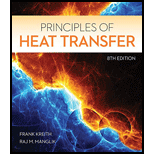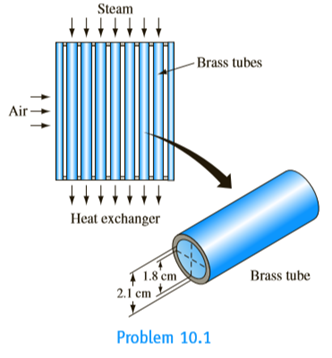
In a heat exchanger, as shown in the accompanying figure, air flows over brass tubes of 1.8-cm 1D and 2.1-cm OD containing steam. The convection heat transfer coefficients on the air and steam sides of the tubes are

(a)
The overall heat transfer coefficient based on the inner tube area.
Answer to Problem 10.1P
Over all heat transfer co-efficient based on inner surface area is
Explanation of Solution
Given information:
Inner diameter of the tube
Outer diameter of the tube
Air flows outside the tubes and steam flows inside the tubes.
Convective heat-transfer coefficients onair side and steam side are
From Appendix 2 (Table 10),
Thermal conductivity of brass
Part a:
Over all hear transfer co-efficient based on inner surface area.
Over all heat transfer co-efficient based on inner surface area is given by (refer to Equation 10.4 in text book)
(b)
Overall heat transfer coefficient based on outer surface area of the tube
Answer to Problem 10.1P
Overall heat transfer coefficient based on outer surface area of the tube is
Explanation of Solution
Overall heat transfer coefficient based on outer surface area of the tube is given by (refer to equation 10.3 in text book)
Overall heat transfer coefficient based on inner surface area is 50.36
Want to see more full solutions like this?
Chapter 10 Solutions
Principles of Heat Transfer (Activate Learning with these NEW titles from Engineering!)
- Air enters the compressor of a regenerative gas turbine engine at 310 K and 100 kPa, where it is compressed to 900 kPa and 650 K. The regenerator has an effectiveness of 75%, and the air enters the turbine at 1400 K. Assume variable specific heats for air. For a turbine efficiency of 90 percent, determine the amount of heat transfer in the regenerator. The amount of heat transfer in the regenerator is kJ/kg.arrow_forwardAir enters the compressor of a regenerative gas turbine engine at 310 K and 100 kPa, where it is compressed to 900 kPa and 650 K. The regenerator has an effectiveness of 79 percent, and the air enters the turbine at 1400 K. Assume constant specific heats for air at room temperature. The properties of air at room temperature are cp = 1.005 kJ/kg·K and k = 1.4. For a turbine efficiency of 90 percent, determine the amount of heat transfer in the regenerator. The amount of heat transfer in the regenerator is kJ/kg.arrow_forwardHints: Find the closed loop transfer function and then plot the step response for diFerentvalues of K in MATLAB. Show step response plot for different values of K. Auto Controls Show solutions and provide matlab code NO COPIED ANSWERS OR WILL REPORT!!!! Use own solutionarrow_forward
- what is shear stress and normal? how to tell them while calculating?arrow_forward12 mm 45 mm 20 kN 20 kN 12 mm 45 mm PROBLEM 1.61 For the assembly and loading of Problem 1.60, determine (a) the average shearing stress in the pin at C, (b) the average bearing stress at C in member BC, (c) the average bearing stress at B in member BC. PROBLEM 1.60 Two horizontal 20-kN forces are applied to pin B of the assembly shown. Knowing that a pin of 20-mm diameter is used at each connection, determine the maximum value of the average normal stress (a) in link AB, (b) in link BC.arrow_forwardHow do you find these answers?arrow_forward
- 250 mm 400 mm A B C E F 250 mm PROBLEM 1.52 Each of the two vertical links CF connecting the two horizontal members AD and EG has a 10 × 40-mm uniform rectangular cross section and is made of a steel with an ultimate strength in tension of 400 MPa, while each of the pins at C and F has a 20-mm diameter and are made of a steel with an ultimate strength in shear of 150 MPa. Determine the overall factor of safety for the links CF and the pins connecting them to the horizontal members. 24 kNarrow_forward50 mm 12 mm B O C OA 300 mm 450 mm E PROBLEM 1.51 Each of the steel links AB and CD is connected to a support and to member BCE by 25-mm-diameter steel pins acting in single shear. Knowing that the ultimate shearing stress is 210 MPa for the steel used in the pins and that the ultimate normal stress is 490 MPa for the steel used in the links, determine the allowable load P if an overall factor of safety of 3.0 is desired. (Note that the links are not reinforced around the pin holes.)arrow_forward3. A 15% magnesium chloride solution is flowing through a 5-nom sch 40 commercial steel pipe at a rate of 325,000 lbm/h. The average temperature of the magnesium chloride solution as it flows through the pipe is 10°F. Determine the convective heat transfer coefficient inside the pipe.arrow_forward
 Principles of Heat Transfer (Activate Learning wi...Mechanical EngineeringISBN:9781305387102Author:Kreith, Frank; Manglik, Raj M.Publisher:Cengage Learning
Principles of Heat Transfer (Activate Learning wi...Mechanical EngineeringISBN:9781305387102Author:Kreith, Frank; Manglik, Raj M.Publisher:Cengage Learning
